#and manifesting that as Dark Link/Zelda or something similar would be a way to make it work in the game
Text
Maybe my hottest ToTK take is that I think, keeping all the gameplay mechanics the same, it would have worked better as a low stakes game with the goals of helping Hyrule rebuild and investigating Zonai ruins, with the later triggering the appearance of the Sky Islands and the depths as well as granting Link (or Zelda, there's zero reason Zelda can't be playable) Ultrahand and the other abilities (which in turn are super helpful for rebuilding!)
You can even keep most of the Regional Phenomenon without changes, either as things caused by the Sky Islands' emergence or frame it as the monsters' final attempts to maintain control after the Calamity's defeat.
There just wouldn't be Ganondorf waiting in a hole the whole game and Zelda wouldn't have been lost in the past. There wouldn't be really urgent things you should be doing instead of exploring or helping the towns, that would be the whole point. Just Link and/or Zelda making discoveries and helping people.
#tears of the kingdom#totk#I think there could even still be a final boss if you think there'd need to be#honestly I've seen people talk about ways Dark Link could have fit in and I think something along those lines would be really cool#not necessarily actually Dark Link but some manifestation of Link and Zelda's fears that the peace they've helped achieved isn't real#because they haven't actually achieved peace for themselves until they can face that fear#and manifesting that as Dark Link/Zelda or something similar would be a way to make it work in the game
6 notes
·
View notes
Text
Undeath in the Era of the Hero of Time : 1
aka Seeing the Hero’s Shade in this TP replay shook up all my feelings of agony again and now I’m working backwards from there because I like to hurt myself.
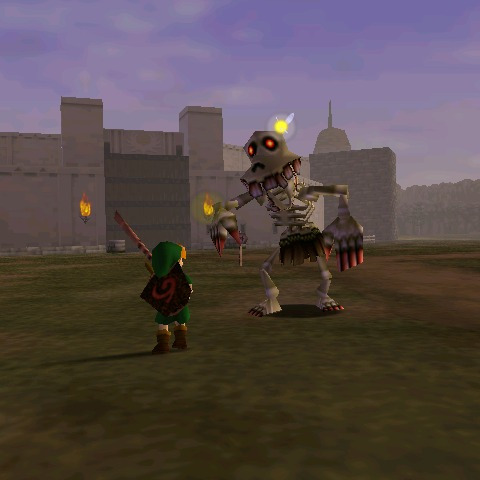
Part One: An Overview of How Fucked Things Are ™
aka The Blood Soaked Hyrule of OoT’s time
Take it as you will, in the Zeldaverse, the colour green has an overwhelming association with undeath.
Sure, sure, life too, I hear you. Farore came down and produced all the living beings that would uphold the law, apparently (specifically not claiming monsters and demons, but that’s another thing). On the surface, that make sense. Forests, lush green fields, prosperity, all of those good things. Green the colour of the most common rupee, green the colour of the Hero’s tunic. Green the colour of magic, and potions that revitalise the body and spirit.
The thing is, revitalising the body and spirit is a flexible idea. To imbue something with new life and vitality can have a lot of implications, especially when you stop talking about the strictly living.
I feel vitality is certainly the best word, not only because of it’s association with life and potency ala the Goddess origin stories, but in the ways that the game uses green itself, such as a measure of both magic and stamina. Green is the colour chosen to represent the unlocked potential within young Heroes.
Vitality specifically refers to a state of being strong and active, and it also refers to the continuance of something to exist. That’s a great thing for plants, or economies, or a potion taken by a young Link who’s swung their sword around or fired off a spell one too many times and feels a little low.
But the dead, though?
As it happens, Hyrule is absolutely littered with human remains, in no small part due to the very recently ended civil wars.
The Civil War, if you need the reminder, is described as a time when the many races of Hyrule were divided and each focused on establishing dominion over the Sacred Realm (because Triforce). I touched on this in my last meta post, but basically, its no holds barred to stop that from happening because if the wrong person gets into the Sacred Realm and makes a wish, it immediately malfunctions.
The criteria for getting into the Sacred Realm and touching the Triforce without royally fucking everything, is basically impossible for anybody not chosen by Hylia.
If you are neither of Hylia’s Bloodline (The Hyrulean Royal Family) or one of her Chosen Avatars (The current incarnation of the Hero), you are not supposed to touch the Triforce. Ever. You WILL be found wanting, it WILL shatter, the Sacred Realm WILL be corrupted by your selfish desires, it WILL unleash and onslaught of mystical influence (reflecting your heart) onto the country.
Now, if it’s Zelda or Link who touches it, that’s fine. Good vibes will pour out. An age of prosperity will ensue. The Sacred Realm is in its default state, a blank and neutral wellspring of magical force.
The game has been rigged from the get go because Hylia still had a job to do. She had to get creative because Demise almost captured the flag, so to speak, leading to the snafu of the Cycle and all that because she cheated at the game, but ultimately Hylia’s task was to guard the Triforce. And that still remains true, for the most part. The Hyrulian Royal Family (and the Shiekah by extension) had to stop at absolutely nothing to win the wars and unify the country, and retain the stasis of the Realm and Triforce, because that’s what their divine orders are.
That’s what they’re supposed to do, ‘the very reason that they’re born’, to lend a quote from King Daphnes. With Hylia on their side by default, they’re willing to do a lot of fucked up things to make sure that happens, ‘for the greater good’.
These dark times are a result of our deeds... -- TP Zelda
In OoT The Sheikah are known as the Shadow Folk. They are heavily associated with death, whether that is caring for the dead’s rest in the graveyard, or working as spies and assassins on behalf of the Royals, or dabbling in various forms of necromancy. Red eyes are an established trait of their people. I will note that, at least from a Japanese point of view, red is often used with the intention of intimidating evil spirits. But it is also a color identified with power and vitality.
So, one could suppose, the Sheikah red eye also symbolises power/control over evil and darkness (spiritually).
That’s a little something that plays nicely with things like the OoT Manga’s explanation of the tear on the eye (and the previous betrayal of the Royal family) and the high probability of a Shiekah faction defaulting during the wars and being banished with other traitors to become the Twili. I know the manga isn’t canon and also SS Impa has a tear, but if you squint, that might be because of her own feelings of personal failure to the Goddess after Hylia’s shedding of her Divinity. You could headcanon that. The existence of the Yiga later in BoTW as a similar happening of division and betrayal lend some more weight to things.
Also, Sheikah who defaulted during the civil war might have even been the ones who actually utilised the Shadow Temple.
Headline: Necromancer ninjas in the process of torturing enough info out of the enemies of the Royal family, who were reportedly seeking the Sacred Realm, decide ‘hey fuck it, let’s take it ourselves’.
That certainly fits into the description of, ‘interloper skilled with dark magic started to appear, seeking dominion of the Sacred Realm’, for me.
Anyway, to the point.
In ostensibly one of the most haunted areas of the game, Kakariko village, we’re treated to the Graveyard and the Royal Family’s Tomb, the Shadow Temple, and the Bottom of the Well. All of these showcase the obvious death and torture that went on, as well as the creepy byproducts of places so saturated with blood, pain, regret, and hatred.

There are skulls in little alcoves on the walls of the catacombs, literally built of bones, who deliver messages to Link. The ones that whisper these messages are all marked by the glowing green eye sockets. Here, the green is used to make the presence of a ghostly sentience inhabiting the skull.
Unsettling. Musty. 4/10 heebie-jeebies.

The Deadhand, giver of childhood trauma that it is, really does its job to hammer home the fact that there has been so many deaths, so much anguish and horror, that those remains can seemingly form into entirely new monstrosities. An amalgamate of undead flesh and nightmare fuel, made up of the body parts of torture victims and the grudges of lingering spirits, seeking to consume the living vitality of whatever comes near-- Link wearing green around the thing might as well be red to a bull.
When defeated in game, it typically drops a small green pot that refuels Link’s magic.
This is a common theme with undead enemies, specifically the ones that are of the zombie flavour. Redeads, Gibdos, Deadhands. All of them generally give up, effectively, distilled magic as a drop item.
Terrifying. Probably smells even worse. 11/10 heebie-jeebies.
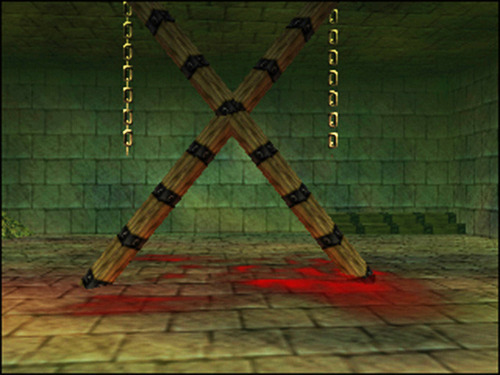
Literal torture device. So many people died here, the room has a green tinge to it. It is soaked in the spiritual imprint of the pain and anguish that took place here. Blood sits here looking freshly spilled, despite the civil war ending many years prior and the Shiekah having ‘died out’, save Impa.
Elsewhere in the temple and under the well, blood splatters are darker red and at least have the decency to pretend to be old. This means one of two things:
Impa still has to make sacrifices to the Seal that contains Bongo Bongo, or feeds people to the undead creatures who lurk down in the dark so they don’t wander up. (Cue the gasp of ‘so that’s why she let the Hylians into Kakariko! Every so often one of them goes missing!’)
Which is a fun dark headcanon to play with, but probably not the case.
Or more likely, the residual spiritual energy that the green haze suggests manifests fresh blood in a manner typical of extreme hauntings. For the victims, their hatred and pain persists so strongly, that their blood seeps up from the cracks no matter how long it has been.
Poltergeist shit. Slip hazard. 8/10 heebie-jeebies.
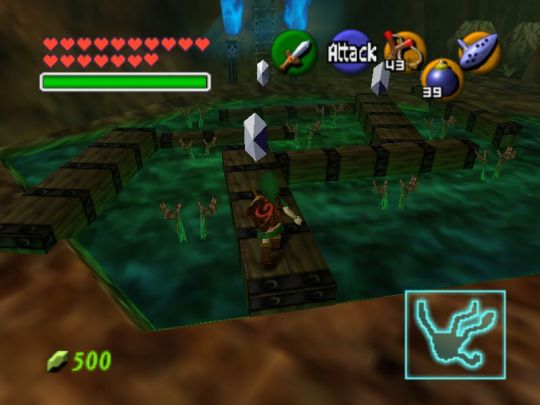
Then there is this. Some people say its just another torture thing, it could have been intended to convey some sort of acid dip. If not torture, maybe bodily disposal. And sure, that’s a reasonable guess.
But it is at the very bottom most cavern of the Well of Three Features, and if it were acid-- for how long the bodies have just been marinating in it-- you can assume nothing would be left of them to stick out. And the fact that all the bodies are neatly spaced, with the arms oddly preserved. They’re presumably like that from lowering bodies in from the wooden beams, the victims may have been tied up with their arms straight upwards.
But, given the Redeads wandering around nearby, I’m pretty sure that’s what this thing does. Make Redeads.
The liquid itself hurts Link, but Link is also alive, and this pool seems to be lacking much of a glow. It’s green, sure, but it’s not exactly teeming with energy. And I think that might be part of its designated purpose-- extracting that green vital energy from living prisoners, draining them until they’re dead. I’m talking juicing people and scooping out the good stuff like the pulp from a really disturbing OJ.
But still steeped in the juice as a corpse, you’re basically pickled in magic brine, so then those gross husks crawl out as Redeads. (Hey, you know what’s handy in wartime? Scaring the shit out of enemy forces by sending some zombies at them. And if they kill them, you’ve lost nothing. If the Sheikah could actually control them? Undead soldiers. Excellent stuff.)
But all the pulpy good stuff is gone, and has been for a while, so most of the bodies in there haven’t pickled in enough magic to reanimate, I suppose.
Human juicer that churns out zombies. Out of juice currently. 6/10 heebie-jeebies.
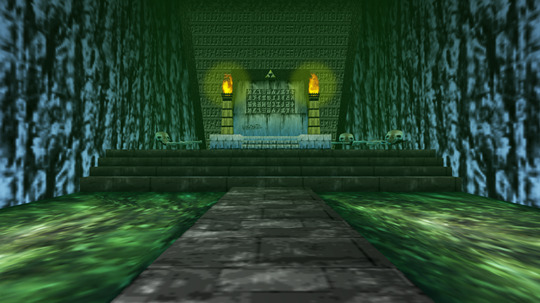
Now, THIS is active zombie juice, if I’ve ever seen it.
This is the Royal Family’s Tomb, by the way. Note the skeletons, picked clean, missing a lot of bones. And that’s a choice they made, because there are also full skeletons around to find.
There are plenty of Redeads down there, for good measure, so I’m going to assume the skeletons are potential graverobbers who were eaten. If Sheikah can presumably command the dead, then the Redeads down there might actually be a counter measure against thieves. If a thief freaks out in the dark when he realises there’s undead down there trying to eat their face, there is also a good likelihood they’ll trip and splash into this green death. A few seconds of exposure is probably enough to kill the average person, and then if their corpse stews for a bit, you have another Redead.
Their living energy revitalises the goop. Their body becomes bolstered security measures. It’s a self sustaining system.
Horrific but effective. 5/10 heebie-jeebies.
Also, there’s a chance that a couple of the skeletons or one or two Redeads down there are the remains of the Composer Brothers. But they will get their own special part in this series, covering Poes in particular.
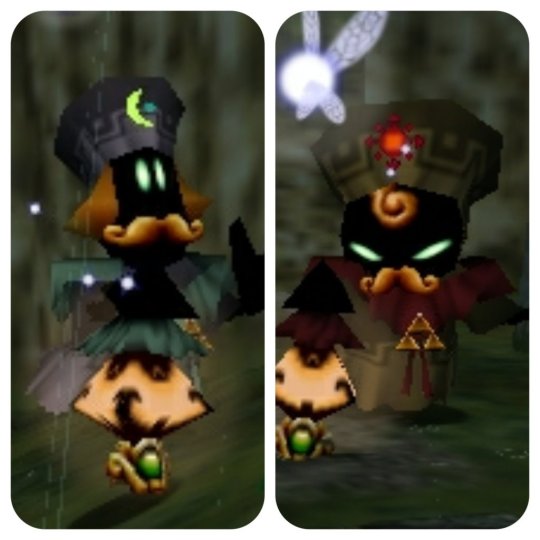
But for the moment, let it be noted: their eyes are also that ghostly green.
Poes are spirits that are unable to move on and who have the unfortunate fate, if left unattended, of turning into phantom monsters who forget their human selves and prey on the living. They tend to pop up the most in two places. One, the Kakariko Graveyard, is obvious and somewhat expected. Dead people, lots of lingering spirits, most of them probably Sheikah and Knights of renown who died in the line of duty. Understandable.
So when you apply the same thought to the fact that Hyrule field is the second most common place to find them, you may as well be concluding that it’s an enormous mass grave of war casualties.
We have established that mass quantities of concentrated death, especially earth that is saturated by the spilled blood of strong soldiers and highly skilled warriors (full of life and magic, as it were), can result in creepy shit made from human remains reanimating over time.
Poes share their haunting of the field with these bumpkins:

These hauntings are not the result of Ganondorf, or the corruption of the Sacred realm. They are not a particular curse placed by anybody.
The Poes and Stalfolk are present in the game from the very beginning, and quite normal fare for Hyrulean life. Lon Lon ranch and castle town are walled off for good reason, and the drawbridge raises at night specifically in response to the literal skeleton monsters who roam around at night.
Stalchildren, specifically, seem akin to the Deadhand in that they are not a direct reanimation of any one particular set of remains. Rather, they seem to be mutated amalgamations of various parts. In the case of the Stalchildren, they rise up under the dark of night, a not-quite-human formation of bone and magic. They seem to possess an aimless drive to attack, perhaps possessed still by the orders of the soldiers who died there.
Interestingly, in a somewhat similar fashion to BotW’s blood moon reanimating the fallen monsters (due to the potency of Malice in the land peaking at those times), Stalchildren only seem to be active under the moonlight. They disintegrate when the sunlight touches them, which promotes the idea that they are the bones of the fallen possessed by the ghostly memory of the war.

They also appear to wear raggy leather kilts, which is a feature they share with the related monster, the Stalfos, who are often acting out the part of a soldier as well. Even better, those bastards are actually WEARING GREEN, to boot, which given the history of Hyrulean Knights prior and their uniforms (SS and Minish cap) is pretty self evident.
Stalfos, however, are also confirmed as humans who have died under certain unique circumstance (such as the magical influences of the Lost Woods) and reanimated as a consequence of what I assume is basically magic poisoning.
It could be a bit like an overdose, succumbing under the intense mystical forces at play within proximity to the Deku Tree (which the strong of spirit can resist). It could be a draining effect, maybe even just a gaseous version of what’s happening when people come into contact with the green goo, except extracted by the forest spirits and plants (also possible that the strong of spirit might resist). That could go either way.
The forest absolutely does eat people’s spiritual energy, though. RIP to Grog and Link’s mother. They’re Stalfos now.
"Anybody who comes into the forest will be lost. Everybody will become a Stalfos. Everybody, Stalfos."
Upon killing both kind of Stal, however, the bones rapidly deteriorate into flames.
You guessed it: green.
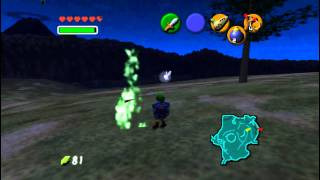
I’ve already pointed out a BoTW reference already, but to add more context back into this thing about the tie between green and things in Hyrule that refuse to die properly:
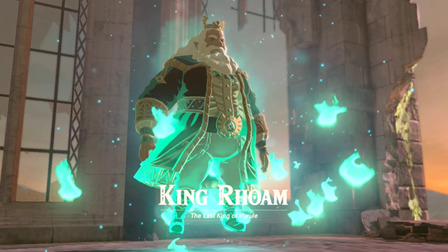
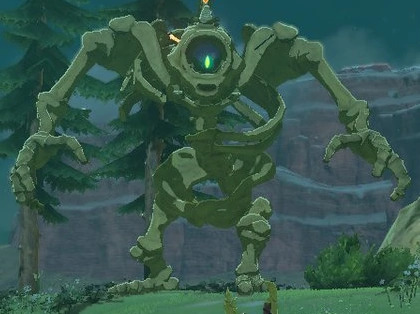
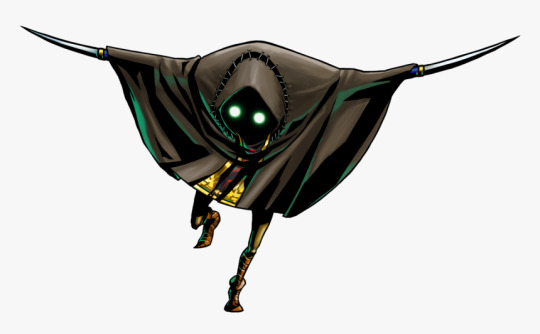

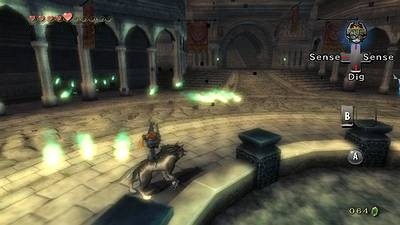

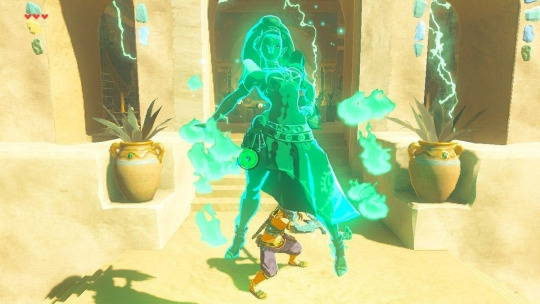
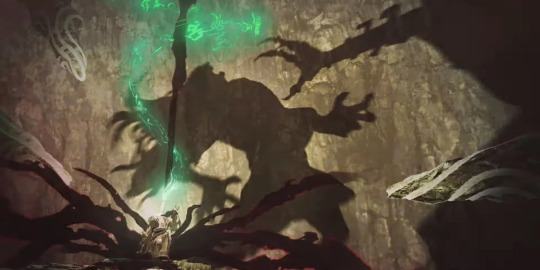

That last one is cheap of me I’m sorry but we’ll get to him too
So we have established that green has an overwhelming association with not only life, but states of undeath.
The overview is, things were already pretty fucked in OoT Era before Ganondorf got the Triforce.
On to part 2!
#tloz#legend of zelda ocarina#Ocarina of time#link#zelda lore#zelda meta#zelda theory#zelda theories#zelda discussion#death tw#blood tw#shadow temple#shiekah#stalfos#poes#undead tw#long post#hero of time#hyrulean history
43 notes
·
View notes
Text
Game Review — Hyrule Warriors: Age of Calamity
Well, it’s that time. While some might already know at least a good chunk of my feelings due to one or two posts I’ve made while playing, I’ve now beaten the newest Hyrule Warriors game (at least in terms of the main story + secret ending) and I think it’s time for me to write up a review.
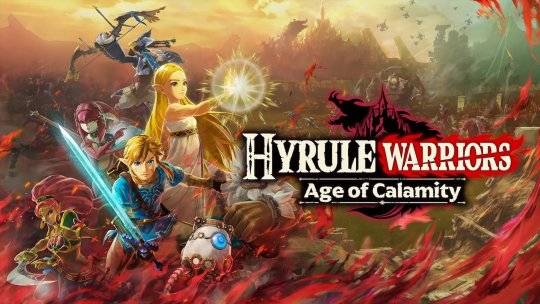
Overall Score: 5.5/10
I know there are probably at least a few Legend of Zelda fans out there who want to tear me apart right now, but I urge them to actually read everything I have to say before they do. I’ve been a fan of this series since I was nine years old (I started with Ocarina of Time and Link’s Awakening simultaneously), and while my favorite Zelda game was Majora’s Mask for a very long time, Breath of the Wild unseated it and also took the spot as my favorite video game of all time, period. Thus, my expectations for this game were already pretty high, and the fact that Nintendo lied in the marketing . . . well, we’ll get to that. But overall the point that I’m trying to make is that I am a diehard Legend of Zelda fan, and I did like the original Hyrule Warriors as well, so this isn’t a case of “she just doesn’t like Zelda” or “she just doesn’t like Hyrule Warriors.” I promise my opinions are more educated than that. So with that said, let’s get to it (under a cut / on my blog for formatting reasons).
The Pros:
The little touches to make sure that Age of Calamity felt like it belonged in the same realm as Breath of the Wild made my heart sing the moment I first played the demo. Hearing the same menu sounds, seeing the same UI — all of that made me feel like I was returning home, and I really hadn’t realized just how much I missed the world of Breath of the Wild until that moment. While it is a Hyrule Warriors game for sure, it’s clear that they didn’t want to make it “Hyrule Warriors 2″ as much as they wanted to make it a Zelda game befitting Breath of the Wild, and I really appreciated the respect that went into that.
Overall, the voice acting was pretty top notch. Zelda’s voice still bothers me—there are times when she sounds okay, but I still wish they’d chosen a different actress to voice her—and Riju’s voice was a little weird, but overall the voice acting was just as good as it was in Breath of the Wild and I was happy to see every single cutscene voiced.
They put a lot of effort into giving everyone distinctive playstyles, even when it came to two characters of the same race who use the same weapons (e.g. Revali and Teba). The Neo Champions weren’t just clones of the previous Champions; rather, they stood out in their playstyle so that while you might like playing as one, perhaps you don’t like the other as much. (For instance, I hated playing as Revali, but Teba was very fun to play as.) And while I did stick with Link most of the time, there were enough characters that I really enjoyed playing as that it was no problem at all to me when I needed to switch characters mid-battle. In particular, I really loved playing as Impa and Urbosa aside from Link, with Riju, Zelda, and Teba as backups.
The music was incredible, but that’s to be expected from a Zelda game, let’s be honest. Of particular note is this track, which filled my heart with awe every time I heard it due to the inclusion of the Song of the Hero (seriously, when that choir kicks in at about 1:45 . . . [chef’s kiss]). But really, the entire soundtrack was incredible. I don’t think there was a single bad song. Which, again, is typical of a Zelda game, but I still feel it bears note.
Being able to pilot the Divine Beasts was AWESOME, no doubt about it. The best one (in my opinion) was Vah Naboris, followed by Vah Medoh. Vah Medoh was the easiest to use, but Vah Naboris was the most fun. After that comes Vah Ruta, which seemed always on the verge of dying, and then Vah Rudania. I just didn’t have as much fun with those two.
As far as I can tell, there aren’t any Points of No Return as far as the overworld quests go. While this does offer a gameplay and story segregation break (e.g. you can still face the Yiga as enemies even after they join you), at the same time I like it because you have to complete all the quests to get 100% completion, and it’d be rather awful if quests were deleted / cut off after a certain story point without warning.
Similarly, you can replay even main story quests at any time, which is useful for gathering materials you might need for other quests (or gathering apples which you need for healing and which, for some reason—I’ll save this for a later section).
The Neutrals:
Terrako. I just . . . okay. On the one hand, I hate Terrako because it is the catalyst for all the bullshit that happens in the plot, and the fact that Terrako was actually the most important one all along is annoying af. (Who will be key in defeating Calamity Ganon: The Hero & Princess of prophecy, or one eggy boi? The answer may surprise you!) But on the other hand, Terrako actually has a personality and is kind of cute as hell, and it was really sad when he succumbed to the brainwashing and you had to murder him. The memories Zelda has of King Rhoam taking Terrako away when she was a child as she sobbed and screamed for him to stop were also painful. So it’s like, I would like Terrako if, say, he’d been introduced in Breath of the Wild 2 as a tiny Guardian that Zelda built after the events of Breath of the Wild as like, a little companion / pet of sorts. In theory I like him as Zelda and Link’s child. On the other, I hate its role in this game, so I have really complicated feelings on Terrako over all. (I also apparently can’t decide which pronouns to use, but somehow I get the feeling that Terrako doesn’t even know what pronouns are and thus probably wouldn’t care.)
While the missions themselves were usually fun, the gameplay really isn’t friendly to anyone with any sort of carpal tunnel or anything similar. That is to say, a little bit of button mashing like this game’s gameplay requires made my thumb and wrist ache something awful. As a result, while I did have fun playing, I also experienced pain playing, and so I can’t really decide if this is good or bad, especially since there at least was some strategy involved depending on who you chose to play as (yet I feel it was less finessed than in Breath of the Wild, but since it’s a Warriors game that’s not too surprising to me).
The missions were fun, but they followed a similar format to the first Hyrule Warriors where you were going to be doing the same tasks over and over and over in different missions (e.g. capture the outposts, etc). The one plus is that I feel there was a bit more variety here in that there were escort missions and the like too, but again, that wasn’t too much and so it could get a little tiring after a bit.
It was nice being able to see a lot of characters from Breath of the Wild that I loved again, but honestly? I feel like it was mostly a wasted opportunity because none of them (at least no one in the main group) received any more development or fleshing out that we didn’t already see in Breath of the Wild. In fact, arguably they were flattened. Revali was an arrogant, argumentative jerk from start to finish, with none of the respect he had for Zelda or any softer sides showing through. We saw that Mipha had a crush on Link and that she was protective over Sidon, but we already saw that in the original game + Champion’s Ballad. We saw that Urbosa was caring, but again, we’d already seen that . . . and so on. This was an opportunity to delve into each of them deeper, but the game just rehashed what we already knew of them from the previous game rather than going into it in any more depth. Arguably the only ones we got to see more sides of were, of all characters, Kohga and Rhoam, and even that wasn’t much. So while it was nice to see these characters again and spend more time with them, I also feel that there was a major wasted opportunity in terms of writing and characterization, particularly since we never saw any major bonding moments with them unlike what we saw in the Champion’s Ballad on photo day.
I LOVED Purah, but I was insanely disappointed that she wasn’t a playable character. At first I thought it might be because they didn’t want to give us two Sheikah, but they were fine giving us two Rito, two Zora, etc, so I don’t see why Purah couldn’t have been playable. Yeah, she’s a scientist, but she’s also a freaking ninja. You can’t tell me she wouldn’t be able to defend herself. So while I’m happy that she had such a big role in the plot (bigger than Robbie, arguably), it disappoints me that we weren’t able to play as her.
Astor is a fascinating character, and I feel it’s at least heavily implied that he was the oracle who foretold Calamity Ganon’s return in the actual timeline. But that’s not specified and we really don’t learn anything about him other than Ganon apparently chose Astor himself, and wanted to use him as his right-hand, so that was a bit of a letdown all things considered. If he was the prophet, why didn’t Rhoam say anything? And how could Calamity Ganon choose Astor from the Dark World, or wherever he was sealed this time? Before playing my original thought was that Astor was basically like Agahnim — that is, a manifestation of Ganon that he uses to act while he’s still sealed in the Dark World, rather than an actual person who exists. But that doesn’t seem to have been the case, so . . . who knows.
Some of the maps could be really frustrating, in that the path to take either wasn’t clear enough or there were gates closed with no clear clues on how to open them, blocking off an outpost you needed to get it. My method of getting around this was usually to tell one of the A.I. characters to go there and then follow them (or switch to another character and tell the character I had been playing with to go there and trust the A.I. to accomplish it, etc) but it was still pretty annoying. That said, at least there were ways around it, and the maps themselves tended to be pretty big and well detailed, so I don’t hate the map design too terribly.
Did Sooga die? I honestly could not tell. On the one hand, it sure seemed like he died considering he was never again shown in a cutscene after Astor betrayed the Yiga Clan. On the other, I seem to vaguely remember seeing him on the battlefield sometimes and I find it very strange that Kohga wouldn’t mention wanting to avenge Sooga in particular if he was dead. But I honestly couldn’t figure out whether Sooga was dead or alive, so this goes in the neutral category for now because I don’t know whether to be mad about it or not.
The Cons:
NINTENDO. FUCKING. LIED. ABOUT WHAT. THIS GAME. WAS SUPPOSED. TO BE.
Yes, that needed to be bolded, and yes, it needed to be in all caps. Nintendo advertised Age of Calamity as a canon prequel to Breath of the Wild. They did it over, and over, and over again. And do you know what? They lied! Because Age of Calamity is not, and could never be, a canon prequel to Breath of the Wild. It can’t be, because it’s an Everybody Lives AU that negates Breath of the Wild in its entirety. And as someone who downloaded the demo thinking that this was going to be a canon prequel—as someone who tried to hold out hope for that even with the warning signs in the demo—that made me really angry, upset, and concerned about the canon sequel. Because you see, Breath of the Wild merged the original three timelines so that we wouldn’t have to deal with split timeline nonsense anymore. But now Nintendo, for some incomprehensible reason given that Aonuma himself was allegedly the one who didn’t want to have to deal with split timelines anymore, went ahead and created a new one. And my concern is whether any of the bullshit that happened in Age of Calamity will affect Breath of the Wild 2 or not. Realistically it shouldn’t, given that Age of Calamity can’t lead into Breath of the Wild at all. But with the Neo Champions having gone to Age of Calamity to help them, I have concerns. Major concerns. If Age of Calamity affects Breath of the Wild 2 in any way, I’m going to be livid.
And before I continue, let me just take a moment to say this: It’s not that I wanted to see the Champions be murdered, per se. I love all four of the Champions and I think that their deaths were absolutely tragic. But at the same time, that was kind of the entire point, or at least part of it. The fall of Hyrule and the death of the Champions were traumatic scars on the land. Countless people died that day, on top of the Champions being murdered in their Divine Beasts. Link himself technically died, or at least very nearly did. Entire villages were wiped out. You can still see those ruins on the landscape, untouched, crawling with monsters. But despite that, over the past 100 years, Hyrule has rebuilt. People are still alive, and are still thriving in different villages across the landscape. Many have not forgotten the past, especially those who had sent Champions to defend Hyrule 100 years ago. But they’ve still continued living, and in that, have refused to let Calamity Ganon defeat them. Moreover, the battle from 100 years ago is not finished yet. Zelda has trapped Ganon in the castle with her and waits for Link to come help her finish things, which they do. The Champions died, but Hyrule did not lose. Hyrule put the battle on pause until they could win, which they did. Breath of the Wild, through having a massive tragedy take place in its backstory, gives us a tale about how victory can be grasped from the ashes, about how you can be broken, but not beaten, and how you can still push yourself up and win no matter how long it takes. That is a beautiful, a powerful story, and taking the Everybody Lives route completely demolishes that.
So suffice it to say, I thought the story presented in Age of Calamity was complete garbage.
But honestly, it isn’t just the story completely demolishing and trashing all over the themes of Breath of the Wild that makes it bad, but it’s also what was done with the characters. There were so many pointless retcons of established story and character elements that were thrown completely out the window that a.) destroyed character relationships and b.) flattened characters and took away what made them well-written in the first place. As just a few examples:
— It is established in Creating a Champion (the Breath of the Wild compendium) that Link pulled the Master Sword from its pedestal when he was around 11 or 12 years old, and thus was known to be the Hero from that point forward. Note that he had already been in the knights at this point; we know from Mipha’s diary in the original game that he visited Zora’s Domain as a small child and was already sparring with adult knights at that time (which seems crazy, but he is the Hero, so). Nevertheless, being the Hero made Link realize just how much was riding on him, and how everyone in the kingdom was now looking to him as the Hero who would save them, personally. This caused Link to completely shut down his emotions out of anxiety of letting the people down or disappointing them in any way. He also stopped talking for the most part, again afraid that he would say the wrong thing and disappoint everyone.
But in Age of Calamity, this is thrown out the window. From a gameplay perspective I get that perhaps they didn’t want you to have the Master Sword at the start, but since you can keep strengthening the Master Sword anyway there’s no reason why they couldn’t have just started it off as a kind of weak weapon that you power up over time. More importantly though is that Link has the same exact personality that he had in the memories in Breath of the Wild, even though he is not the Hero at the start of the game. I mean, he is, but no one knows that yet, and as such he has no reason to be stoic and silent, because his reason for being that way in Breath of the Wild’s backstory is completely gone. We could have gotten to see a goofier, more personable Link (even if they still wanted to keep him mostly silent), but instead we got a stoic, silent Link for literally no reason. It makes absolutely no sense.
— As an added contradiction to the above, Mipha tells Link in Age of Calamity that he “hasn’t changed a bit” when they meet again in Zora’s Domain. This is in direct contrast to her diary, wherein she notes that the wild boy she met when they were both children has changed completely when they meet again as teenagers into someone stolid, though she’s not aware of the reason why. So once again, they doubled down on removing backstory that made Link into a more complex, well-written character.
— To that end, Link and Zelda’s relationship is also rewritten entirely (and by rewritten, I mean “had all complexity stripped from it and with it any meaningful development). Since Link is appointed Zelda’s personal knight because he fights well instead of because he’s the Hero, Zelda has absolutely no reason to resent him being appointed her knight here like she did in the original history. You see, in the original history, Zelda resented Link for seemingly stepping into his destiny with zero effort given, and also thought (because of her own insecurities and the rumors that Rhoam told her to her face were being circulated about her being “heir to a throne of nothing”) that he looked down on her for not being able to awaken her powers and step into hers. For this reason, she spent most of her time either avoiding him or yelling at him, though she notes in her diary that she feels bad for doing so because she knows that it’s not fair of her to treat him badly when he’s technically just trying to do his job. It’s not until he saves her from Yiga assassins that she starts to do a hard reassessment of her treatment of him, and starts to try to get to know him better . . . which results in her getting him to open up to her, and her being able to open up to him in turn, and both of them becoming each other’s confidant. This in turn makes it understandable when it’s Link’s near death which finally allows Zelda to come into her powers; on top of having lost everyone and seemingly everything else, Zelda saw the one person she could be vulnerable in front of about to die protecting her. Link was so important to her by that point, regardless of whether you see her feelings for him as romantic or not, because he supported her emotionally on top of being there for her in physical defense. That is why her powers awakened when they did, why he was the final trigger.
But in Age of Calamity, none of that happens. Zelda doesn’t resent Link because he’s not the Hero at the time he’s appointed her personal knight. Even when he gets the Master Sword later, Zelda is just sad about it rather than holding any sort of resentment or anger toward him. We never see them bond or become close; unlike in Breath of the Wild, where we have memories of Zelda trying to feed him a frog, opening a conversation about fate and destiny and whether one could make a choice in opposition to those things, or scolding him while patching up his wounds, all we get here are repeated scenes of Link defending Zelda from attacks. That’s it. We never see her have any sort of actual conversation with him, we never see them bond or have any non-battle related moments together. We certainly never get an indication that Link opens up to her either, which means that each time he protects her here it’s less “I’m protecting the one person who I’ve been able to open up to about who I really am” and more “it’s all about my paycheck.” Link and Zelda’s relationship, whether you saw it as romantic or not, was the core relationship in Breath of the Wild. And yet, in an alleged prequel (that wasn’t really a prequel after all!), it’s pretty much nonexistent.
— Moreover, Zelda’s character gets flattened, too. Here’s the thing about Zelda in Breath of the Wild: She’s written like a real person. She has many good qualities (selfless, devoted, intelligent), but also many flaws (stubborn, short-tempered, quick to judgement). The way Zelda decided she knew all she needed to know about Link right away and reacted accordingly (and by “reacted accordingly” I mean “treated him badly”) was a result of her flaws. But Zelda realizing that what she was doing was wrong and endeavoring to make things right was a direct result of her good qualities. Breath of the Wild’s Zelda is not a perfect person, not because she has a difficult time unlocking her powers (pretty much anyone would in her position, she was dealt the shittiest hand in the world), but because she’s a realistic person who has flaws and makes mistakes and is just doing her best in a world that is determined to knock her down at any opportunity. As a result, we see a lot of emotional range from Zelda throughout the memories in Breath of the Wild. We see her curious and inquisitive, we see her frustrated, we see her sad, anxious, angry, playful, determined, loving, impatient, brave. She’s a compelling character because she is a character, rather than the Deus Ex Machina perfect princess who exists only to either be rescued or be a holy figure who seals away the evil at the end. (Which I mean, she does seal away the evil at the end, but that’s far and away not the only thing she does.)
But in Age of Calamity we see . . . basically none of that. There are very brief moments where Zelda is curious about technology, or where she daintily laughs at something Terrako does. She does get determination and her anxieties wiped away after she awakens her power near the end. But for 90% of the game all we see from her is her being anxious or sad about her power. We don’t see her get irrationally resentful of or angry toward Link. We don’t see her getting impatient, making hasty judgments about people or animals (remember, she also judged her horse as unworthy of the royal bridle before Link helped her learn how to bond with her horse properly), or doing mischievous things like trying to make her personal knight eat a frog for Science. I’m going to be perfectly honest with you: While I deeply felt for Zelda in the flashbacks of Breath of the Wild, I got tired of her constant “:( I’m useless :(” angst in Age of Calamity. It got old pretty quickly. And most of all, I was so disappointed to see that the character I loved was now just here to be a woobie, rescued by Link half a dozen times and sad for most of the story. Breath of the Wild’s Zelda is my favorite Zelda, and she was done such an injustice in this game. It was immensely disappointing.
— Link and Zelda were not the only issues here, though. The way the Yiga Clan also needs to be talked about, and in order to discuss them, I have to first remind everyone of their history.
So. 10,000 years ago. Civilization was thriving thanks to Sheikah scientists and innovators, who created things such as the Sheikah Slate, the Guardians, and the Divine Beasts. It was this technology that allowed Hyrule to triumph over Calamity Ganon the first time he came around to play (or at least that time that he came around to play), and they won pretty handily at that. However, the Hyrulean King at the time quickly grew suspicious and fearful of the Sheikah. Although the Sheikah had faithfully served the Hyrulean Royal Family for milennia due to their goddess-given oaths, the King of Hyrule felt that the Sheikah not only could, but would use their technology to rebel against Hyrule and dismantle the Royal Family. As a result, he:
- Exiled the Sheikah from Central Hyrule, as well as any villages or towns where Hylians lived.
- Criminalized Sheikah technology, which included imprisoning (or even executing) any Sheikah known to be conducting scientific research, as well as destroying Sheikah technology (or burying what could not be destroyed, such as the Divine Beasts and Guardians).
- Essentially legalized Sheikah oppression.
The people of Hyrule backed the king in his decree, for the most part, buying into the bigotry and prejudice that spurred it on. The Sheikah had everything taken from them and destroyed: their homes, their research, their artifacts, everything. And while some Sheikah remained loyal to the oaths they swore to the goddesses and decided to keep peacefully in a newly formed, yet secret out of fear of retaliation, village (Kakariko), another group of Sheikah were rightfully fucking pissed at being oppressed and subjugated for no good reason, especially right after they helped save the world. Their opinion on the matter was “fuck that guy, AND his entire family.”
These Sheikah became known as the Yiga Clan.
Now, why they felt it was a good idea to side with Calamity Ganon is not entirely clear, given that destroying the world would also mean destroying them. But I think that on top of being furious with the Royal Family for this betrayal, they were also furious with the goddesses, because not a single goddess stepped in to defend them when they were being betrayed and oppressed. The Sheikah had kept loyal to their oaths for millennia, and yet this was how they were repaid. If you think about it like that, then the Yiga siding with the one who would destroy everything and everyone the goddesses had ever created makes a twisted kind of sense, even though it assures their own destruction right along with it.
And now that we’ve refreshed that backstory . . . let us visit what happens with the Yiga in Age of Calamity.
So. First, we see that Astor is the one who has convinced Kohga to go along with reviving Calamity Ganon, even though that doesn’t really make sense since serving Calamity Ganon has kind of been the Yiga’s thing from the get-go, and that they didn’t hate Zelda and Link because Astor told them to, but rather because Zelda was a member of the Royal Family (a.k.a. the people the Yiga have held a grudge against for 10,000 years), and Link is the knight defending her / the Hero. Next, we see that they’re completely aimless without instructions from Astor, which again, doesn’t really make sense considering their goals have always been pretty clear and they’ve been a tightly-run organization from the beginning no matter how bumbling Kohga is. Finally, Age of Calamity has them join the Royal Family and heroes despite this being the antithesis of what they’ve been devoted to for, again, 10,000 years.
And here’s the problem with that:
In Age of Calamity, Kohga’s alleged reasoning for wanting to join with Zelda (and bowing to her, what the fuck) is because Astor used Yiga Clan foot soldiers (and I think Sooga? It was unclear) to fuel Evil Terrako to resurrect Calamity Ganon. Kohga felt betrayed by this and thus decided to take Astor down. Given that the Yiga Clan have been established to hold grudges over betrayal for millennia, Kohga turning on Astor makes sense. However, it was also already established that the Yiga wanted to revive Calamity Ganon to destroy the entire damn world even though it would mean their deaths as well, because they hated the Royal Family and goddesses just that much. So Kohga deciding to join the Royal Family, and actually bowing to Zelda, makes absolutely zero sense and cannot be excused just because they gave him a line about gagging at the fact that he joined up with Zelda. It’s a complete dismissal of and slap in the face to the legitimate reasons that the Yiga Clan had for defecting from the Sheikah, and does absolutely nothing to address the oppression the Sheikah people suffered as a direct result of the Hyrulean Royal Family’s laws. And yes, that was 10,000 years ago and Zelda herself had nothing to do with it, but we also have little evidence that the current Royal Family has done anything to change it, at least for reasons other than their own benefit. It’s stated in Creating a Champion that King Rhoam was the first king since then to reach out to the Sheikah to try to repair that relationship, and that he only did so when the prophecy about Calamity Ganon rising again was made. Moreover, he made sure to keep a very tight watch on the Sheikah scientists, indicating that he still may not trust them. So whiel the actual betrayal was 10,000 years ago, it’s clear that the Royal Family has not once in 10,000 years attempted to genuinely make up for the oppression that was forced upon the Sheikah, and so the Yiga Clan have every right to still be absolutely fucking furious about it. I can’t blame them for that at all, and I hated seeing Kohga bow to Zelda like that for that reason.
(All of this said, no, it doesn’t excuse their other bastardry, such as stealing the Thunder Helm, or murdering the wife of someone who tried to peacefully defect and then threatening to also murder his young children if he didn’t continue to do Yiga missions. The Yiga do some truly fucked up things and that bastardry is not excused by their sad history. However, when it comes to the Royal Family their resentment and fury makes sense, and I hate that this wasn’t addressed in a game that wanted you to team up with the Yiga. They’re not the haha funny bad guys, they’re people who had a legitimate reason to be furious, and the Sheikah as a whole were never given anything remotely close to reparations by the Hyrulean Royal Family. This is something I hope is addressed in Breath of the Wild 2, although my expectations for that are pretty low.)
— Finally, while a much lesser note than all of the above, I also found Riju’s characterization to be questionable. I might be misremembering her small part in Breath of the Wild, but while we learn from her diary that she does have some doubts about her ability to lead the Gerudo at her age (particularly given that the Thunder Helm was stolen from her), I don’t remember her having such low confidence, or being so meek so that she would constantly need Urbosa supporting her. I feel like they may have characterized her that way because she’s a child, which I mean, I guess I understand, but it just felt like an alteration of her character to me. I could be wrong since it’s been a while since I played through that part of Breath of the Wild, but that aspect of her character just felt off to me.
Moving on from the story and the characters, I also have to say that the amount of graphical inconsistencies in this game were really just . . . impressive in number. I’m talking specifically about Link’s different outfits, and whether he would actually be wearing them in cutscenes or not, because honestly? You could never know if he was going to be in the outfit you put him in, or if he was going to be in the Default Outfit for any given cutscene. I get the feeling that the difference lies somewhere in-between whether something was a pre-rendered cutscene or like, a quick time event one, but nonetheless it just felt incredibly sloppy and kind of defeated the purpose, at times, of being able to dress Link how you wanted him.
I had issues with the gameplay at times as well, apart from what I already mentioned before. Namely, I found it incredibly frustrating how sometimes, despite being locked on to an enemy, the Sheikah Slate apps wouldn’t actually target that enemy (e.g. Stasis activating on a bokoblin instead of the targeted attacking Lynel). Similarly, I wasn’t a fan of how A.I. characters couldn’t be easily pointed around the map at times, refusing to go to certain locations until you swtiched to them and forced them to go there (e.g. when you had to manually make them jump down to the field during the Akkala Citadel battle).
Why in the actual hell can you not a.) eat ingredients other than apples during battle to heal, and b.) BUY APPLES LIKE ANY OTHER INGREDIENT? Holy fuck it was so goddamn annoying having to go into random battles to try and scrounge up apples from crates and boxes, and only really being able to do it from lower level battles because higher level battles wouldn’t give them as readily to "increase difficulty” (more like to increase frustration). I see no reason why you couldn’t purchase apples from shops, or eat other food items like berries or fish like you could in Breath of the Wild. Apples didn’t even heal that much health, so you had to mash several of them at once late game, and you could only hold a small number and couldn’t buy more . . . frustrating. Just absolutely frustrating for no good reason. (Like if it was a harder difficulty restriction I’d understand, but for normal difficulty? Jeez.)
All in all, if Nintendo had just been upfront and honest about this being an alternate universe game from the very start, I probably wouldn’t have been as furious as the story as I was. I would have still been disappointed, but the anger wouldn’t have been there at the very least. But the weren’t honest—they lied in order to get people to buy the game, and so that dragged the score down along with everything else. While I did like some aspects of this game, overall I feel that it could have been so much better, and all I can hope is that none of it affects Breath of the Wild 2 in any way, shape, or form.
#2020 game reviews#hyrule warriors: age of calamity#loz: age of calamity#''Scrawlers why do you get so mad when things about LoZ are wrong''#because I'm a FUCKING NERD that's why#this game strongly triggered my Super Nerd Wants To Fight instinct & the only ones who should be sorry are Nintendo
32 notes
·
View notes